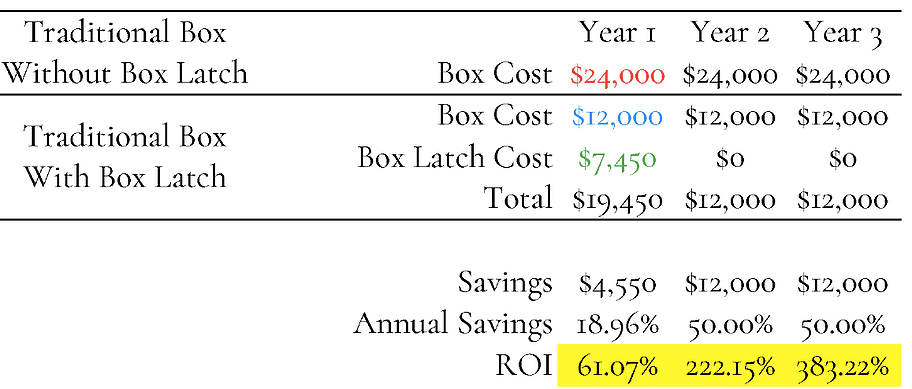Enstrom Candies, Inc. Case Study
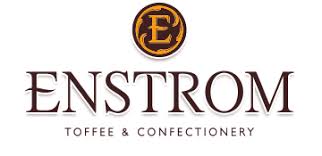
Box Latch™ Products Case Study
Company: Enstrom Candies, Inc.
NEW PRODUCT: What a major candy company is doing to save on boxes and how you can, too.
Quick Take
Enstrom Candies, Inc. in Grand Junction, Colorado recently teamed-up with Box Latch™ Products (BLP) to integrate a new and unique packaging “gadget” into their company. The flagship product from BLP they are using is the Box Latch and it, has changed the way Enstrom uses and re-uses their boxes. Hold on, I already know what you’re thinking – “Here we go again, another packaging solution that’s gonna save the world”. If you know us by now, you know that Heevit isn’t interested in the “fluff” of salesman fast talk. If we come across any packaging product or service that’s communicated to be impactful, unique, and claims to make a difference, we’ll travel to witness it ourselves and share the story.
So that’s what we did.
In this article, we’ll share our experience at Enstrom through an insightful factory tour concluding with the packaging of Enstrom’s confections and how the Box Latch™ has made a considerable impact towards reducing packaging costs and the environmental detriments related to excess packaging.
If you haven’t already, please be sure to check out our interview with Jack Wilson who serves as Box Latch™ Product’s Head of Product Development and COO. Our interview provides a brief glimpse of the people and innovation behind the Box Latch.
Who
If you’re a fan of toffee, it’s practically obligatory to be a fan of Enstrom Candies, Inc. This family owned and operated candy company has proudly created and served-up their famous almond toffee out of their 60,000 sq. ft. facility in Grand Junction, Colorado since 1960. Adhering to the traditional recipes first formulated by Founder Chet Enstrom, Enstrom Candies has continued to offer their traditional handmade almond toffee in parallel to an ever-growing line of confections. Our visit to their headquarters was led by Doug Simons Jr. who represents the fourth generation of candy-makers within their family lineage.
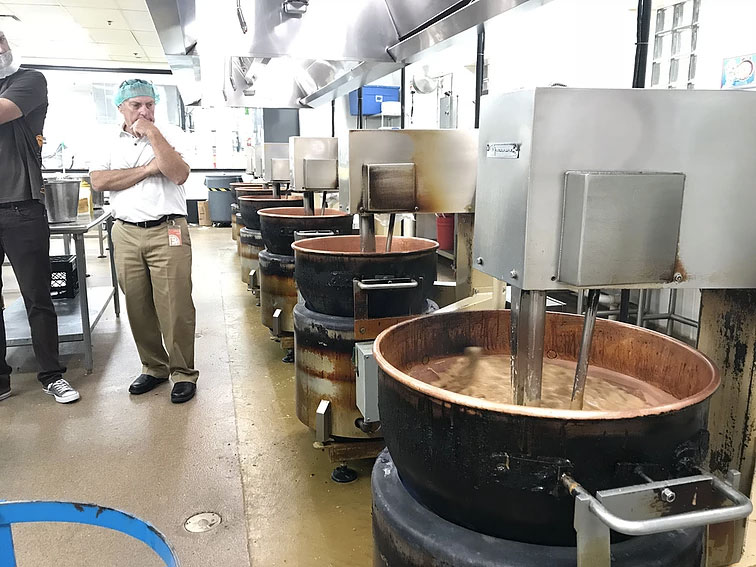
Churning
Jack Wilson of Box Latch observing Enstrom’s traditional almond toffee-making process alongside Doug Simons Jr. of Enstrom Candies, Inc.
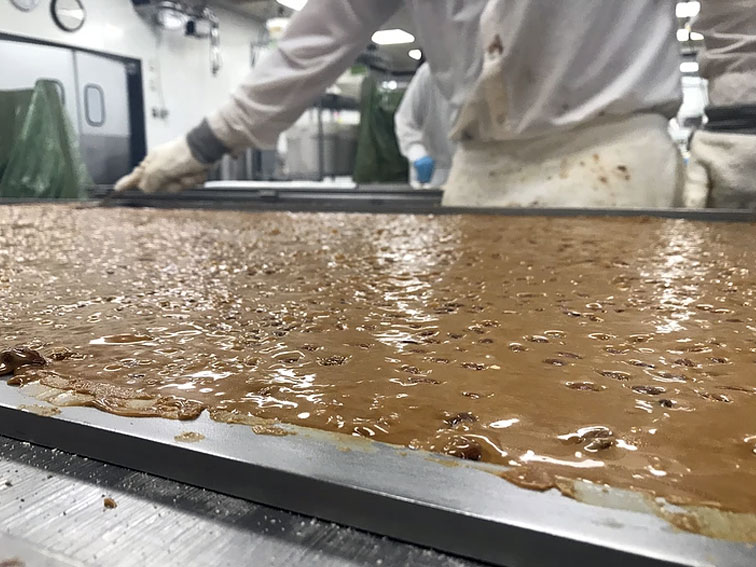
Layer of Toffee
After churning, the almond toffee mixture is poured onto a water-cooled stainless steel tabletop and spread evenly by hand. Each batch of Enstrom toffee contains 20 lbs. of butter!
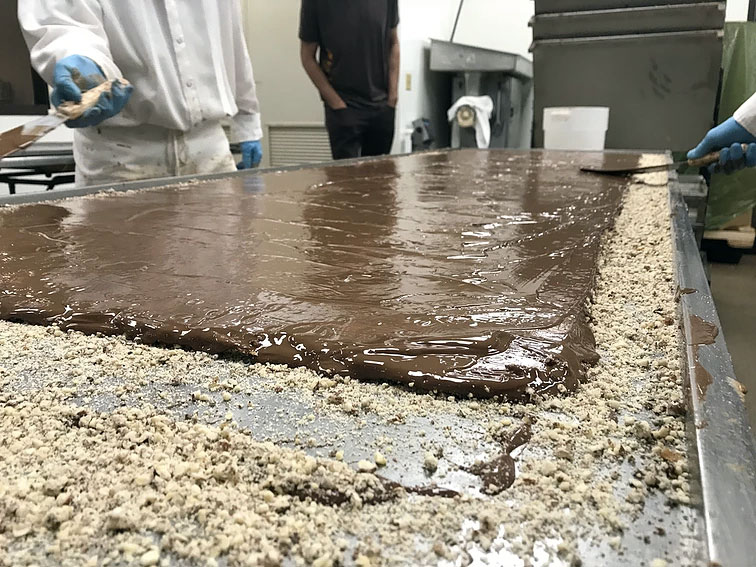
Never Enough Chocolate
It takes a team of two candy-makers to pour and spread a thin layer of chocolate over the entire toffee sheet.
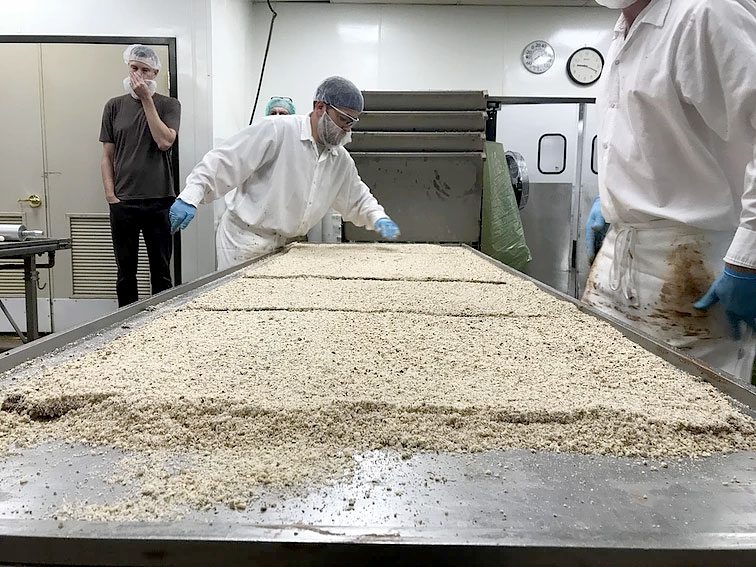
A Smattering of Almonds
A generous shower of crushed almonds encapsulates the toffee as it dries. The toffee is now ready to be cut to size for packaging.
So what’s the problem?
At the tail-end of Enstrom’s toffee-making process is the boxing and palletizing of their individual candy boxes in preparation for storage inside a -10 degree Fahrenheit freezer. Enstrom’s toffee boxes are stored frozen until they are ready to be shipped at which time they are removed from the box in which they were stored.
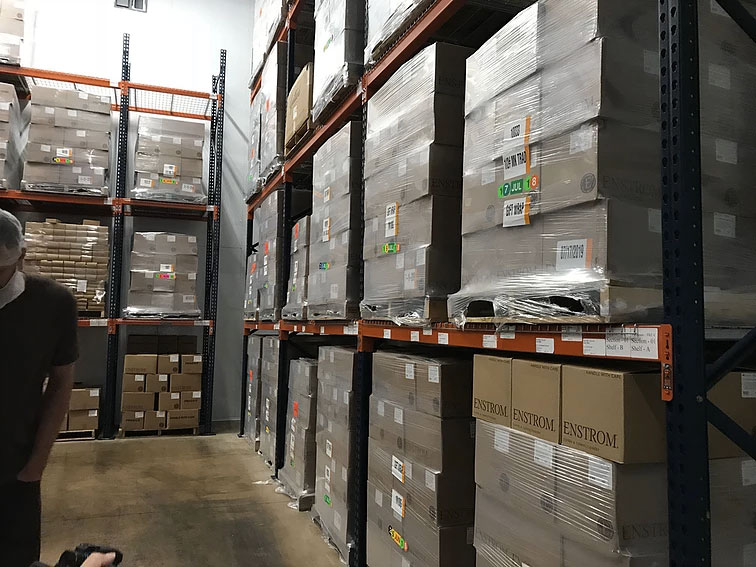
Palletized & Stored
Enstrom toffee boxes temporarily stored in -10 degree Fahrenheit freezers. All boxes have been closed using the Box Latch.
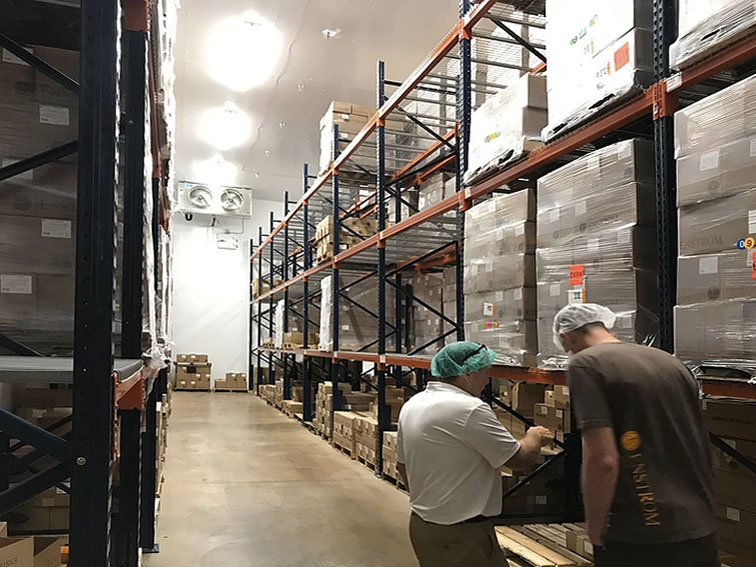
Doug & Jack in the Freezer
Jack Wilson of Box Latch observing Enstrom’s traditional almond toffee-making process alongside Doug Simons Jr. of Enstrom Candies, Inc.
Before the Box Latch™, Enstrom’s boxes were either taped or, on occasion, “dog-eared” which proved to compromise their integrity over a short period of time. They claimed that they were able to use each box up to three times before they were discarded due to the wear and tear resulting from taping or “dog-earring”. Enstrom wanted a way to get many more re-uses out of their boxes and the only way that was going to happen was to find an alternative way of closing them:
Other concerns came from the packers themselves who would complain about the box flaps scratching their forearms when packing box after box with the “dog-ear” method. Up until now, taped or “dog-eared” boxes were just accepted as common practice and pretty much the only two options when it came to closing boxes; temporarily or permanently. Now, let’s take a look at how the Box Latch™ performs in the same packing scenario:
The Box Latch makes temporarily closing boxes presentable, reliable & possible.
The Numbers
Traditional Box Without Box Latch™
Prior to Enstrom’s use of the Box Latch™, their boxes yielded, on average, a total of three uses per box before discarding. An order for boxes placed in Month 1 would last them thru Month 3 at which time another order for 5,000 boxes was required to replenish supply in Month 4. This process was repeated throughout the year amounting to annual usage and expenditure of 20,000 boxes and $24,000, respectively.
With the Box Latch™, Enstrom’s box re-usability increased quickly and dramatically. An order placed for boxes and Box Latches in Month 1 means annual box expenditure is now half of what it used to be with enough Box Latches to be used and re-used indefinitely. Although the long-term verdict on re-uses is still out, because of the Box Latch™, they are now using each box six times; that’s twice as many uses than before!
Within the first year, an impressive savings in box expenditure of 18.96% and ROI of 61.07% sets the tone for the savings pattern to follow in years to come. Note that the Box Latch™ purchase cost from Month 1 in Year 1 is recouped quickly with Years 2 and 3 yielding considerably higher savings and ROI percentages.
The product is simple and the impact is real
Since the beginning of 2018, Enstrom Candies has grown to the point of using more than 20,000 of the Box Latches at their Colorado facility. Equally as impressive as the cost savings generated by the Box Latches are the positive environmental impacts. The more times the Box Latches can be used, the more it translates directly to the decreased need for new boxes to be manufactured which, in turn, means FEWER boxes that end up being thrown away. To date, Box Latch™ Products claims to have saved over 1,000,000 boxes from ending up in the landfill or having to be recycled.




